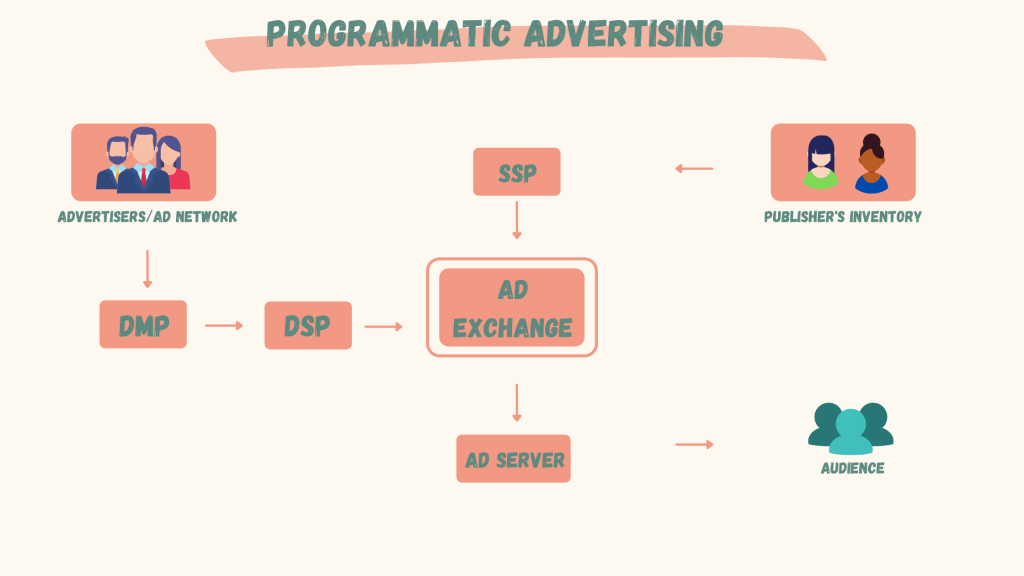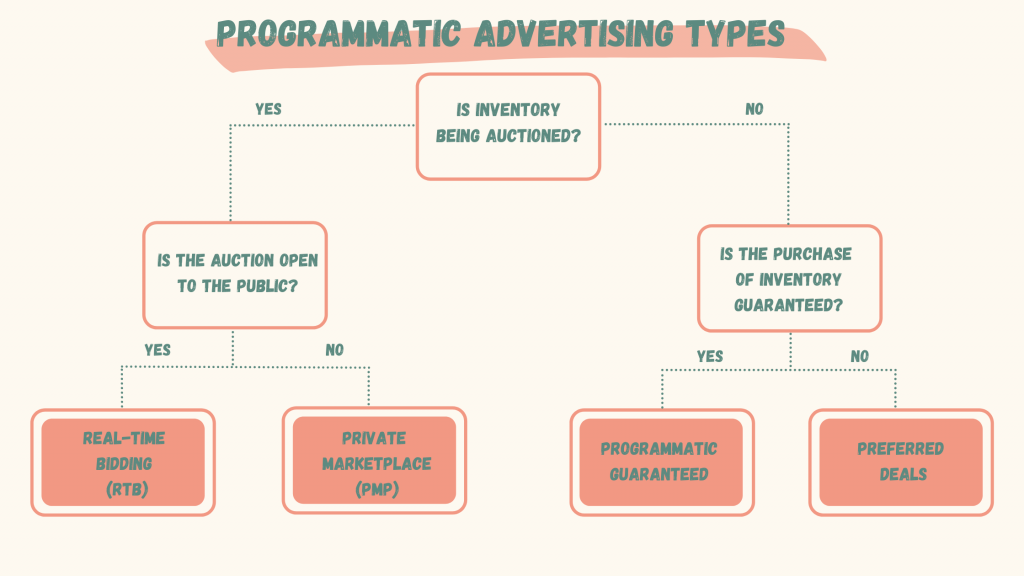
Programmatic advertising is one of the most popular (and preferred) ways of buying and selling ad space — for both publishers and advertisers alike. The technique uses technology to automate inventory purchasing in a way that cuts down the effort (and error) of traditional direct sales. Although it’s commonly thought of as display advertising, programmatic advertising supports many types of media buying (display ads, native, video, etc.). As a result, It’s not just a flashy trend in digital advertising, but the future of it.
Key terms to know
Jargon and tech-talk surrounding programmatic advertising can be overwhelming. However, being familiar with a few key terms can alleviate any headaches and confusion. So, let’s take a moment to get comfortable with the lingo.
- Ad space: area on a publisher’s website reserved for ads (synonyms: ad unit, ad inventory, media space)
- Ad exchange: a marketplace for buying and selling publisher inventory
- Demand-side platform (DSP): automation software that allows advertisers to manage and buy ads
- Supply-side platform (SSP): automation software that enables publishers to manage and sell their ads
- Ad server: the technology that stores and distributes advertiser’s ads/contents
- Data management platform (DMP): software that collects, stores, and segments third-party data. The information is shared with advertisers, who then build better-targeted campaigns to reach their desired demographic.
- Ad network: a group containing specific advertisers
The benefits of programmatic advertising
- Simplicity: With an automated process, bloggers no longer need to find and connect with advertisers to fill their ad space. Instead, ad earning becomes more passive.
- Better quality ads: Since programmatic advertising creates better targeting abilities for advertisers, publishers get more relevant ads. Additionally, quality control is improved; limiting ad fraud and spam bloggers previously dealt with.
- Ad management platforms: The rise of programmatic advertising has created a wave of ad management platforms that service publishers. These programs help publishers access various types of programmatic advertising, optimize ad units, and use AI and algorithms to better their ads.
- More money (!): With advertisers having more knowledge at their hands, they can better allocate their ad spending. As a result, publishers get higher payouts.
Real-Time Bidding (RTB)
Real-Time Bidding (RTB) is the most common form of programmatic ad buying. The bidding model enables the buying and selling of ads – on an ad impressions basis – through an instantaneous auction. RTB also goes by open marketplace, open auction, and open exchange, because the ad exchange platform ‘opens’ the auction to the public – so any ad network can bid on any website.
How it works: As soon as a user loads a webpage, publisher ad slots are available through an SSP. Advertisers offer a bid amount, and the highest bidder wins the auction. The site then serves the winner’s ad to the viewer in the ad slot. It’s fully optimized thanks to property tech and happens in real-time instantaneously. As a result, advertisers can serve more impressions at a quicker rate.
- Pros: RTB enables better pricing precision. Additionally, bloggers get a better fill rate because the arrival of a visitor is what triggers the auction.
- Cons: It’s less transparent for advertisers, so they may choose to funnel a more significant bulk of their ad spending into other types of programmatic deals. Publishers are also unaware of the advertisers bidding for their slots.
Private Marketplace (PMP)
In the same vein, private marketplace bidding (PMP) is similar to RTB because it takes place in a bidding fashion. However, only select advertisers can partake in the auction. As a result, PMP also goes by private auction, private exchange, or invitation-only auction.
How it works: A user loads a webpage with ad units, triggering a real-time auction. Next, a DSP holds a private auction in which a handful of pre-selected advertisers can access it using a time-sensitive deal ID. Publishers set a floor price for their ad space, so bidding begins there. Again, the highest bidder wins and has their ad served to the user.
PMP tackles the lack of transparency advertisers and bloggers experience in an open auction. On account of being invite-only, advertisers are aware of who the publishers are and vice versa. As a result, advertisers can better reach their target audience, and publishers can improve ad relevancy.
- Pros: Publishers get incredibly high payouts and relevant ads for their viewers. Additionally, publishers can be picky about whom they choose to work with.
- Cons: It’s just as competitive for publishers to gain access to PMP auctions.
Preferred Deals
A preferred deal is when a publisher sets aside ad placements for a specific advertiser to use. Using audience data and website metrics, an advertiser and publisher will enter into a deal that benefits them both. In other words, advertisers get ‘first-dibs’ on high-performing inventory and a relevant audience. And publishers get to work with advertisers of their choosing — and more money! The deals have an agreed-upon fixed price/CPM rate.
Unlike other types of programmatic deals, this type does not guarantee that the advertiser will bid for the ad unit. Preferred deals are also known as programmatic non-guaranteed, unreserved fixed rate, or spot buying.
How it works: A user loads a web page, triggering an ad request to the advertising network. The network gets a first look at the ad space and can purchase it for the agreed-upon fixed-rate or decline the request. If advertisers deny the request, automation will send the ad unit to an open auction for bidding.
- Pros: Publishers can work with trusted advertisers and get high rates.
- Cons: Preferred deals are primarily for bloggers with an extensive reach.
Programmatic Guaranteed
Programmatic guaranteed is similar to traditional media buying because advertisers and publishers work one on one to create deals. However, AI tech is used to automate the request for proposal (RFP) and the serving and tracking of ads.
Advertisers can work with premium ad inventories, fixed pricing, and better audience targeting. In addition, publishers have the certainty of filling premium inventory at some of the highest rates in the industry. Programmatic guaranteed is also called automated guaranteed or programmatic direct.
How it works: A deal is made between bloggers and advertisers; a set price for a guaranteed volume of inventory. The blogger sets aside the selected premium inventory and is served the advertiser’s ads through the negotiated amount/date.
- Pros: Best quality ads and best rates are at a blogger’s tips.
- Cons: It’s challenging to get into, as you’ll need a high-performing website.

Programmatic Ad Formats
Thanks to ad tech companies, the list of programmatic ad formats available has grown. Rather than being limited to display ads, a publisher’s inventory can now support a wide variety of ad formats. Ad formats are simply different types of ads — they vary in elements like location or media type.
Since the goal of an ad is to draw a user’s attention, ad formats are critical to advertisers and campaigns. The more people they can reach with their messaging, the better their return on investment (ROI) is. Advertisers know certain ad types are more reliable in helping to defeat banner blindness – a user’s tendency to ignore ads. As a result, they prioritize and aim for high-performing ads.
On the publisher side of things, ad formats are just as essential. What ad types you choose to serve will become a part of the user’s experience as they navigate your webpage. For example, intrusive or poorly placed ads can hurt user experience, while organic ads offer a better balance.
Earnings also relate directly to ad formats and performance. You earn more from each ad view or engagement. Additionally, bloggers get higher rates for ads more likely to reach the intended audience. Each ad format has its pros and cons. Let’s explore.
Display ads
In terms of programmatic ad buying, display ads refer to static visuals placed at a page’s header, footer, or sidebar. It’s one of the most common digital ad types and typically operates on a cost-per-click model.
- Pros: They’re non-intrusive, making them great for user experience. Also, they don’t typically impact website speed.
- Cons: Many users have developed banner blindness, so they have low payouts.
Video ads
Video ads are all the rage in digital advertising. They support and serve video footage/content. There are several ways publishers can leverage video ads, and the Interactive Advertising Bureau (IAB) has set industry standards and best practices to assist. In general, there are three ways to place them:
- Instream: These ads exist within a video player already providing video content. Publishers can opt to play them before, during, or after footage. For bloggers already taking advantage of video in their blogs, it’s an excellent way to boost earnings.
- Outstream: These ads exist outside of video content (like within a primarily text-based web page). They can appear as pop-ups, drop-downs, or live anywhere as an ad unit within your content.
- In-display: These ads exist as thumbnails displayed on a video panel. For example, like a thumbnail displayed on YouTube’s recommended video panel for users.
It’s important to note that video ads can be fickle things— so brush up on best practices before throwing them onto your website.
- Pros: Their high demand translates to premium rates for publishers willing to support them.
- Cons: Video coding can be heavy and slow page load speed. Additionally, they can become intrusive or not work at all (missed earnings!) when not set up correctly.
Native ads
Next on the list is native ads. These ad types follow a web page’s overall flow and feel to appear organic. Advertisers will work with a DSP to buy ad space on a third-party website (your blog!). As a result, bloggers get non-intrusive ads, and advertisers get advertisements that help defeat banner blindness.
Rather than being limited to the header, footer, or sidebar, native ads can exist dynamically throughout a page. The ads can be in-feed and in-article on your website.
- Pros: These ad types are great for user experience and core web vitals.
- Cons: You’ll be earning less than you would with other intrusive types.
How to get started with programmatic ads
If you’re looking to access premium ad campaigns and rates, it’s time to get started with programmatic advertising. Advertisers know it leads to better audience targeting, higher conversions, and a higher ROI. So it’s an essential part of their advertising strategy — and should be part of yours too.
Getting started is easy. Ad management platforms are more than happy to do the heavy lifting. We’d be more than happy to connect with you on all things related to how programmatic advertising works or help you take the next steps. Visit Newor Media to get started. We work with publishers to:
- Enable/support programmatic advertising
- Optimize ad units and websites
- Handle the back end of ad management

5 Comments
Comments are closed